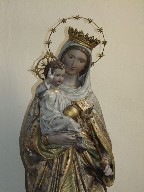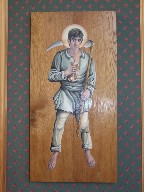| |
|
Our Lady
and St Walstan, Costessey
 |
|
As
was remarked by the anonymous author of That
Great Gothic Fane, published in 1910 to mark
the opening of the huge Catholic church of St
John the Baptist in Norwich, the idea that his
ancestors had been Catholics was as remote for
the typical rural Norfolker as was the idea that
dinosaurs had once walked the land. And yet,
there were pockets in Norfolk where the
Catholic Faith not only survived through the long
penal years, but flourished, and not as an exotic
species. These were the parishes where the local
Big Family refused to switch to the new
protestant Church of England, but stubbornly
clung to the Faith of their forebears. The most
steadfast of all these recusant families were
probably the Jerninghams of Costessey Hall. It is no
exaggeration to say that the Jerninghams were the
architects of the survival of the Old Faith in
Norwich. Although records of a resident Priest
only go back to 1701, Costessey Hall was host to
Mass throughout the penal period, one of few
places in East Anglia of which that could be
said. In the middle years of the 19th century,
Costessey Hall was rebuilt to the designs of JC
Buckler, an architect with two good Norfolk
churches to his name at Welney and Walpole
Highway. Buckler was also commissioned to build a
mission church to go with the Hall - until then,
local Catholics had made use of the Hall chapel.
The result is a tall, rather serious building in
red brick. The high lancets and strong
buttressing create a fortress-like effect,
perhaps understandably as the church opened on
the 26th of May 1841, just five years after the
Reform Act which had made its construction legal.
|
A mark of
the success of its design is that we would still be
building churches in this style until well into the
1890s, but it has none of the nooks and crannies which we
have come to expect of 19th century Catholic churches.
Rather, the effect is that of a protestant preaching hall
church. The west end has had its severity ameliorated by
a modern extension in the early years of the 21st
century. Even so, this building would fit well into an
industrial town.
The first
Priest of this church was a Dr Husenbeth, who had been
appointed chaplain of Costessey Hall in 1820. We may
assume that he was largely reponsible for the design of
the church, which cost a little under £4500 to build,
about eight hundred thousand in today's money, although
this amount also included the presbytery and all the
furnishings. There were about 400 Catholics living in
Costessey at the time, and it is interesting to compare
this with the vast Kings Lynn parish, which covered most
of north-west Norfolk and which at this time had,
according to the Lynn News, less than 150 Catholics
all told, and all of them poor. I assume that most
of the Costessey Catholics were working for the Hall
Estate.
The
Catholic heirarchy was reintroduced to England in 1851,
and at that time St Walstan became a parish church within
the vast Diocese of Northampton. An Order of Nuns took up
residence in the village, and the Sisters opened a
village school. But hard times were coming to Costessey.
In 1872, Dr Husenbeth died, and, with the Jerningham
family no longer able to support the Church in the
parish, the Bishop of Northampton decided not to send
another Priest to Costessey, reasoning that his resources
would be more usefully deployed in the heart of
industrial Norwich. St Walstan's church closed for
regular use, and soon fell into decay. The Parish
reverted to mission status, with Priests coming out from
Holy Apostles chapel in central Norwich to say Mass in
the chapel of the Hall. It was not until 1910,
coincidentally the year that the church which is now
Norwich's Catholic Cathedral was opened, that another
Priest was sent to Costessey, and the Parish brought back
to life.
Our Lady
and St Walstan is open every day. You step into the
modern extension, and then beyond this the church is all
of a piece, the structure and the furnishings all dating
from 1841. The interior is as serious as the exterior -
Pevsner thought it pleasant but plain. A solid,
stone-built west gallery with the linked monograms of
Mary and Walstan is a pleasing counterpoint to Buckler's
apse of a chancel at the other end. The glass in the
chancel is interesting rather than beautiful, its
significance coming from its early date.
| The
stations on the walls echo the bench ends, and
the font is a simple marble tub in the
transitional style. There is a good modern icon
of St Walstan, apparently based on a local, and
the panelled altar provides a moment of High
Victorian splendour. If the
architecture of the church is urban in character,
its setting is wholly delightful. Although we are
just off of Costessey's main street, the church
sits on the crest of a ridge which falls rapidly
away towards the north-east, and here is a
fascinating and lovely Catholic graveyard. The
snowdrops still punctuated the spaces between the
gravestones when we came this way in April, and
among the often elaborate and beautifully carved
headstones is a simple cross on a moss-covered
pedestal. Beside it is a sign which reads Pray
for the Souls of the Jerningham Family, whose
bodies were brought from the chapel in Costessey
Park and buried here on November 18th 1953. Their
names are inscribed in the porch of St Walstan's
Church.
|
|
 |
|
|
|
